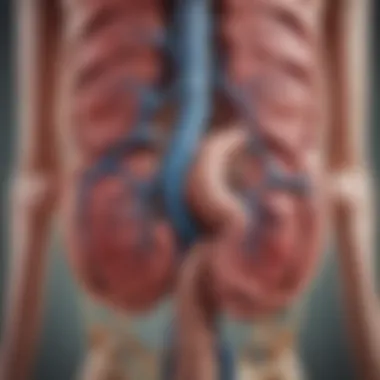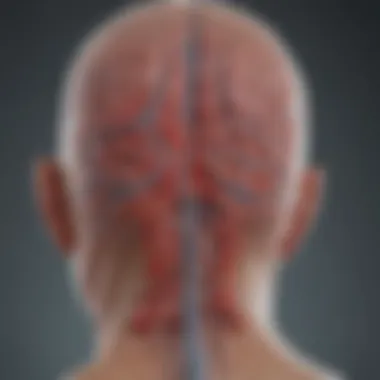Understanding Kidney Disease and Nerve Pain Connection


Research Background
The relationship between kidney disease and nerve pain is complex and multifaceted. Understanding this connection requires a grasp of various physiological processes that occur within the body. Kidney disease, particularly chronic kidney disease (CKD), impacts many systems and has significant implications for neural function and pain perception.
Historically, the focus on renal health has been largely centered around filtration and electrolyte balance. However, over the years, researchers began uncovering the impact of kidney function on the nervous system. Studies have shown that when kidney function declines, the risk for developing neuropathy also increases. This connection raises questions about how renal impairment might lead to specific types of nerve pain known as neuropathic pain. Previous research has highlighted the role of metabolic disturbances and toxin accumulation in individuals with diminished kidney function, suggesting a clear link to increased nerve pain episodes.
Findings and Discussion
Recent studies bring forth significant findings that illustrate the connection between kidney disease and nerve pain. The key areas of focus include:
- Physiological Mechanisms: A buildup of toxins, such as uremic toxins, occurs in kidney disease. These toxins have been implicated in nerve damage and inflammation, contributing to neuropathic symptoms.
- Prevalence of Neuropathy: It is noted that individuals with CKD are at a higher likelihood of developing neuropathies, including peripheral neuropathy. Research estimates that about 60% of CKD patients may experience some form of nerve pain.
- Complications of Diabetes: In cases where kidney disease is secondary to diabetes, the intersection of diabetic neuropathy and kidney dysfunction is particularly notable. Elevated blood glucose levels can damage both kidneys and nerves, compounding the severity of symptoms.
"The relationship between kidney health and nerve pain underscores the importance of comprehensive assessments in patients with chronic kidney disease."
The interpretation of these findings signifies the necessity of multidisciplinary approaches in managing kidney disease. Patient care must address not only the renal functions but also the potential for developing painful neuropathic conditions.
Overall, while the interconnection between kidney disease and nerve pain is becoming clearer through research, further studies are critical for establishing effective treatment methodologies and prevention strategies. This will help to better inform both healthcare professionals and patients about the importance of early detection and management of these co-occurring health issues.
Overview of Kidney Disease
Kidney disease represents a critical area of focus within the medical community due to its extensive impact on individuals' health and quality of life. Understanding kidney disease is vital as it can affect nearly every aspect of one’s health, including the potential for developing nerve pain. This section will delve into essential elements around kidney disease, covering definitions, prevalence, risk factors, and the progression through various stages.
Definitions and Types
Kidney disease, or renal disease, refers to conditions that impair kidney function. These conditions can be broadly categorized into chronic kidney disease (CKD) and acute kidney injury (AKI).
- Chronic Kidney Disease (CKD) lasts over three months. CKD often results from a gradual loss of function, typically due to diabetes or high blood pressure.
- Acute Kidney Injury (AKI) refers to a rapid decline in kidney function, often caused by an injury or severe illness, and may be reversible.
Further classifications within CKD include glomerulonephritis, polycystic kidney disease, and diabetic nephropathy. Each type of kidney disease has distinct characteristics and implications for treatment and management.
Prevalence and Risk Factors
The prevalence of kidney disease has been increasing steadily worldwide. It is estimated that around 10% of the global population suffers from some form of kidney disease.
Common risk factors include:
- Diabetes: the leading cause of kidney impairment
- Hypertension: high blood pressure can adversely affect kidney function
- Family History: genetic predispositions play a significant role
- Age: older adults are more susceptible to kidney issues
- Obesity: additional weight strains kidney function
These risk factors not only highlight the factors contributing to kidney disease but also indicate the populations most at risk.
Stages of Kidney Disease
The progression of kidney disease is typically categorized into five stages, assessed by the glomerular filtration rate (GFR). Understanding these stages is crucial for early detection and intervention.
- Stage 1: Normal or high GFR (90 or more), with some kidney damage and potential protein in urine.
- Stage 2: Mild reduction in GFR (60-89), with evidence of kidney damage.
- Stage 3: Moderate reduction in GFR (30-59), often leading to complications.
- Stage 4: Severe reduction in GFR (15-29), requiring planning for renal replacement therapy.
- Stage 5: End-stage renal disease (ESRD), where kidneys can no longer maintain normal function.
Recognizing these stages allows healthcare professionals to monitor kidney function effectively and plan appropriate management strategies. The interplay between kidney disease and nerve pain emerges prominently as one progresses through these stages, emphasizing the necessity of understanding kidney health in relation to overall well-being.
Understanding Nerve Pain
Understanding nerve pain is essential in the context of this article because it elucidates how the dysfunction of kidney systems can manifest as discomfort or pain in peripheral nerves. Nerve pain, often referred to as neuropathic pain, is particularly intriguing due to its unique characteristics and multifactorial origins. This article will dive into the definition of nerve pain, its types, common causes, and associated symptoms. This establishes a foundation for understanding the nuanced interplay between kidney disease and nerve-related disorders.
Definition and Types of Nerve Pain


Nerve pain arises from injury or dysfunction within the nervous system. It can be categorized into several types based on origin and characteristics. The most prominent categories include:
- Peripheral Neuropathy: This type involves damage to peripheral nerves and is commonly seen in conditions like diabetes. Patients may experience numbness, tingling, or a burning sensation.
- Central Neuropathic Pain: This occurs due to damage to the central nervous system, such as spinal cord injuries or strokes. The pain is often chronic and can be difficult to interpret.
- Radiculopathy: Here, nerve roots are affected, commonly leading to symptoms that radiate along the affected nerve pathway, often due to herniated discs.
Understanding these classifications is relevant for recognizing how kidney disease can exacerbate these types of nerve pains, giving clinicians insight into both diagnosis and treatment strategies.
Common Causes of Nerve Pain
Several factors contribute to the onset of nerve pain. A few notable ones include:
- Diabetes: High blood sugar over time can damage nerves, leading to diabetic neuropathy.
- Infections: Conditions such as shingles can result in nerve pain.
- Trauma: Physical injury can directly damage nerves.
- Nutritional Deficiencies: Lack of essential vitamins, particularly B vitamins, can cause neuropathy.
- Kidney Dysfunction: Impaired kidneys may lead to the accumulation of toxins in the blood, affecting nerve function.
Identifying these common causes is crucial for effective management of pain. For patients suffering from kidney disease, understanding that renal impairment can lead to peripheral nerve damage is a key consideration.
Symptoms Associated with Nerve Pain
Symptoms of nerve pain can vary widely, reflecting the complexity of the nervous system itself. Common symptoms include:
- Burning Sensation: A frequent description from patients experiencing nerve pain.
- Numbness or Tingling: This may occur in localized areas or can extend along the length of affected nerves.
- Weakness: Patients may experience difficulty in using affected limbs.
- Hypersensitivity: Responses to stimuli may be amplified, causing pain from normally non-painful stimuli.
These symptoms can significantly affect the quality of life, particularly for individuals with additional health challenges like kidney disease. It is important to recognize these signs early, as they may indicate more serious underlying issues related to nerve function.
Understanding the symptoms of nerve pain can promote earlier diagnosis and, therefore, intervention, which is vital for improving patient outcomes.
In summary, understanding nerve pain sets the stage for deeper discussions on how kidney disease can influence this condition. By looking into the definitions, causes, and symptoms associated, healthcare professionals can improve the management strategies for those affected.
Linking Kidney Disease and Nerve Pain
Understanding the connection between kidney disease and nerve pain is essential in the landscape of medical science. This exploration holds significance for healthcare providers and patients alike as it can guide improved treatment strategies and enhance patient quality of life. Kidney disease can lead to a cascade of physiological consequences that affect nerve function, making it crucial to recognize how these systems interact.
One important element in this relationship is the physiological mechanisms that underpin nerve pain in individuals with kidney dysfunction. As kidney health deteriorates, waste accumulation in the blood can disrupt various bodily functions, potentially causing neuropathic symptoms.
Physiological Mechanisms
The mechanisms linking kidney disease and nerve pain are multi-faceted. First, uremia, a condition resulting from kidney failure, leads to elevated levels of toxins in the bloodstream. These toxins can damage nerves, causing sensations of pain or other neuropathic symptoms. In addition, metabolic imbalances associated with kidney dysfunction can lead to changes in nerve signaling pathways. Furthermore, inflammation often accompanies renal impairment, which may exacerbate nerve pain through heightened sensitivity.
Moreover, kidney disease can contribute to alterations in blood flow and oxygen supply, impacting nerve health. For instance, compromised renal function can lead to cardiovascular issues, affecting peripheral circulation. When nerves do not receive sufficient blood flow, this may trigger pain responses.
The Role of Kidney Dysfunction in Neuropathic Pain
Kidney dysfunction does not act alone in the development of nerve pain. This linkage is influenced by various factors. For one, the degree of kidney impairment significantly affects the severity of neuropathic symptoms. Patients with advanced kidney disease are more likely to experience pronounced nerve pain than those in the earlier stages. This correlation may be attributed to cumulative physiological alterations, such as increased toxin levels and systemic inflammation, as renal function declines.
Additionally, other comorbid conditions, such as diabetes, commonly coexist with kidney disease. Diabetes is a well-known contributor to nerve pain due to its effects on blood glucose levels, resulting in diabetic neuropathy. The intersection of these conditions complicates management, demanding a nuanced understanding of underlying pathophysiology.
Acute vs. Chronic Kidney Disease and Nerve Pain
Differentiating between acute and chronic kidney disease is crucial when assessing the relationship with nerve pain. In acute kidney disease, nerve pain may manifest suddenly, possibly related to rapid metabolic shifts or obstruction. Patients often report temporary pain that resolves with the restoration of kidney function.
Conversely, chronic kidney disease tends to have a more insidious onset of nerve pain. It often progresses over time, with patients experiencing gradually worsening symptoms. Etiologically, the prolonged buildup of toxins and sustained inflammatory states in chronic cases make nerve pain more complex. Addressing these differences is vital for tailoring effective pain management strategies.
Clinical Implications
The interrelationship between kidney disease and nerve pain carries profound clinical significance. Recognizing this connection is vital for effective patient management. Kidney disease can lead to complications affecting not just renal functions but also neural systems. Understanding these implications helps healthcare providers offer comprehensive care that addresses both renal and peripheral nervous system challenges.
Challenges in Diagnosis


Diagnosing the effects of kidney disease on nervous function presents unique challenges. The symptoms of nerve pain can often be vague and overlap with other medical conditions. It is essential to take a thorough patient history, as individuals may present with pain that stems from multiple sources. For example, diabetic neuropathy is common in patients with kidney issues, leading to confusion in diagnosis. Thus, it is crucial for clinicians to be vigilant and understand that obvious symptoms may not be the root cause.
"An early diagnosis can significantly improve patient outcomes by tailoring appropriate treatment strategies."
Assessment Techniques for Kidney Function
To accurately assess kidney function, clinicians often utilize various techniques. Blood tests, such as serum creatinine and blood urea nitrogen, are common initial assessments. Glomerular filtration rate is calculated to evaluate how well kidneys are filtering waste. Additionally, a urinalysis can help detect proteinuria, which may indicate kidney damage. Radiologic imaging, such as ultrasound, can reveal structural abnormalities in kidneys that contribute to nerve pain. Regular assessments allow for early detection of renal impairment, enhancing overall patient management.
Evaluating Nerve Pain in Patients with Kidney Disease
When it comes to evaluating nerve pain in patients with renal disease, a multidisciplinary approach is beneficial. Patient-reported outcomes are critical in understanding pain severity and its impact on daily life. Clinicians may use validated pain scales to quantify symptoms, alongside neurological examinations to assess sensory and motor functions. Identifying comorbidities, such as diabetes, is important for developing targeted pain management strategies. Comprehensive evaluations ensure that clinicians address all aspects of a patient’s discomfort while considering their renal status.
Management and Treatment Options
In addressing the multifaceted relationship between kidney disease and nerve pain, it is essential to have a comprehensive approach to management and treatment options. A well-structured treatment plan allows healthcare professionals to alleviate pain, optimize kidney function, and improve the patient’s quality of life. Each component of management must be tailored to suit individual patient needs, taking into account the severity of kidney disease, the nature of nerve pain, and the overall health profile of the patient.
Pain Management Strategies
Managing pain effectively is paramount for patients who suffer from both kidney disease and nerve pain. Here are some strategies that may be employed:
- Non-pharmacological methods: Techniques such as physical therapy, acupuncture, and biofeedback can provide relief from nerve pain. This can be particularly beneficial for patients hesitant to rely solely on medication.
- Cognitive Behavioral Therapy (CBT): CBT can help patients cope with chronic pain. This can improve mental health alongside physical symptoms.
- Complementary therapies: Some patients find relief through practices like yoga and meditation. These modalities promote relaxation and may reduce the perception of pain.
Medication Considerations
When addressing nerve pain in patients with kidney disease, medication must be approached with caution. Certain medications may exacerbate kidney issues or interact negatively with treatments for kidney disease. A few key points to consider include:
- Analgesics: Medications like acetaminophen can be considered safe, while non-steroidal anti-inflammatory drugs (NSAIDs) should generally be avoided due to their potential to compromise kidney function.
- Antidepressants and Anticonvulsants: Drugs such as duloxetine and gabapentin are often effective for neuropathic pain. However, their dosage might need adjustment based on the individual’s kidney function.
- Monitoring: Regular monitoring of kidney function is essential when prescribing medications. Adjustments in dosage may be required to prevent toxicity.
Role of Dialysis and Transplantation
For patients with advanced kidney disease, dialysis or kidney transplantation may become necessary. These interventions can play a significant role in managing both kidney function and associated nerve pain:
- Dialysis: This treatment helps filter waste from the blood. By managing kidney function, it can potentially alleviate some pain associated with kidney disease. Pain may still persist due to the underlying nerve damage, necessitating additional pain management strategies.
- Transplantation: A kidney transplant can enhance overall health and potentially reduce neuropathic symptoms. Successful transplantation often improves metabolic processes and organ function, which may mitigate some pain syndromes.
"Effective management of kidney disease and nerve pain requires a personalized approach that considers all aspects of a patient’s health."
These strategies are not only meant to relieve symptoms but also aim to create a sustainable quality of life for individuals navigating the complexities of both conditions. A thorough understanding of the interconnection between kidney disease and nerve pain can guide healthcare providers in formulating effective treatment regimens.
Preventive Measures
Preventive measures play a critical role in mitigating the impact of kidney disease and related nerve pain. By implementing strategic approaches, individuals can reduce the risks associated with these conditions. Effective prevention involves a multifaceted strategy that includes lifestyle modifications, dietary recommendations, and regular monitoring. This section explores these essential elements, emphasizing their collective benefits in maintaining kidney health and managing nerve pain.
Lifestyle Modifications
Lifestyle changes are fundamental in preventing kidney disease and managing nerve pain. Key modifications include:
- Regular Exercise: Engaging in physical activity helps maintain a healthy weight and supports optimal kidney function. It can also alleviate nerve pain by improving blood flow and reducing inflammation.
- Stress Management: Chronic stress impacts overall health, including kidney health. Techniques such as meditation and yoga can promote relaxation, which may lessen nerve pain.
- Avoiding Tobacco and Excessive Alcohol: Both tobacco and alcohol can exacerbate kidney function decline. Quitting smoking and moderating alcohol intake can lead to improved health outcomes.
Making these adjustments can not only improve kidney function but also help reduce occurrences of nerve-related discomfort.
Dietary Recommendations
Diet plays a crucial role in kidney health and nerve pain management. Patients should consider the following dietary strategies:


- Low Sodium Intake: Reducing sodium can help manage blood pressure, a critical factor for kidney health. High sodium levels can lead to fluid retention and increased kidney stress.
- Adequate Hydration: Staying hydrated supports kidney function and aids in eliminating waste products, which is essential for preventing nerve pain associated with kidney disease.
- Balanced Nutrient Consumption: Emphasizing foods rich in antioxidants, healthy fats, and lean proteins can foster overall health. Foods such as fruits, vegetables, nuts, and fish can provide necessary nutrients while reducing inflammation that can impact neural pathways.
Adhering to these recommendations can provide substantial benefits in managing both kidney disease and nerve pain.
Monitoring and Regular Check-ups
Regular monitoring and check-ups are vital for those at risk of kidney disease and nerve pain. Key aspects include:
- Routine Blood Tests: Regular tests can help track kidney function and detect any changes early, facilitating prompt interventions. Tests like creatinine clearance and eGFR (estimated Glomerular Filtration Rate) are particularly important.
- Nerve Function Evaluations: Assessments of nerve function can identify nerve damage early. These evaluations may include electromyography (EMG) or nerve conduction studies.
- Consultation with Healthcare Providers: Continuous communication with healthcare professionals can ensure that changes in symptoms or health status are addressed promptly. This proactive approach is crucial in managing chronic conditions effectively.
Regular check-ups can catch early warning signs, improving opportunities for intervention and health management.
Research Directions
The exploration of the interconnection between kidney disease and nerve pain is a burgeoning field, laden with complexities that warrant extensive research. This section emphasizes the necessity of focusing on research directions to enhance understanding and treatment modalities for those affected by both conditions. The increasing prevalence of chronic kidney disease, correlated with neuropathic symptoms, underscores the urgency for targeted studies.
By analyzing the intersections between these two areas, researchers can uncover crucial physiological and biochemical pathways that may lead to the development of new therapeutic strategies. Moreover, this research can illuminate the potential impacts on patient management and care protocol.
Current Research Trends
Recent studies indicate a growing acknowledgment of the kidney's role in peripheral nerve health. Several findings have pointed toward kidney dysfunction contributing directly to neuropathic pain. Key trends in current research include:
- Biomarker Discovery: Scholars are investigating biomarkers that indicate renal impairment and its subsequent effect on nerve health. This could improve diagnostic accuracy and time.
- Epidemiological Studies: Various large-scale studies are assessing the prevalence of nerve pain in kidney disease patients. A common finding attributes a high incidence of neuropathic pain in those undergoing dialysis.
- Mechanistic Understandings: Research is focusing on elucidating the mechanisms by which kidney disease influences nerve function. This includes investigating how toxins accumulate due to impaired renal clearance.
These trends reflect an integrated approach combining clinical observations with laboratory-based research, providing a more nuanced understanding of the kidney-nerve pain connection.
Future Areas of Investigation
As the field evolves, several potential avenues for future research stand out for their transformative prospects. Considerations for what should be explored next include:
- Neuroprotective Strategies: Understanding how certain treatments could shield nerve function in patients with renal issues is vital. Future studies might explore the use of certain antioxidants or medications that support nerve health in these populations.
- Kidney Disease Progression: Investigating how nerve damage impacts the progression of kidney disease can yield valuable insights. Clarifying whether nerve pain exacerbates renal impairment could reshape treatment protocols.
- Patient-Centered Research: Engaging with patients to gather qualitative data on their experiences with kidney disease and nerve pain will enrich our understanding of symptomatology and management priorities.
Each of these areas offers the opportunity for groundbreaking discoveries that could enhance patient outcomes and the overall quality of care.
Impact of Emerging Therapies
Emerging therapies in both nephrology and pain management show great promise with implications that could significantly improve the treatment landscape. Key areas of interest include:
- Neurmodulation Techniques: Innovations such as spinal cord stimulation or peripheral nerve stimulation have emerged as alternative pain management techniques that may benefit patients experiencing nerve pain stemming from kidney disease.
- Pharmacological Advances: New medications targeting both kidney function and nerve pain symptoms, such as certain dual-action analgesics, could reshape treatment approaches. Understanding their dual effects may be a game changer for clinical practices.
- Genetic and Personalized Medicine: The tailoring of therapies based on genetic profiles holds potential for a more efficacious treatment of patients with overlapping kidney and nerve conditions.
Bringing together multidisciplinary expertise in research can expedite the translation of these emerging therapies into clinical practice, ultimately fostering better patient outcomes.
"The future of research directions must focus on collaborative approaches to unlock new treatment pathways for those suffering from the intertwined burdens of kidney disease and nerve pain."
Culmination
In reviewing the intertwining relationship between kidney disease and nerve pain, it becomes clear that this topic holds significant implications for both patients and clinicians. The exploration of how renal impairment impacts neurological function is not merely academic; it fosters a deeper understanding that can guide clinical practice and patient care. Addressing the nexus of these conditions is crucial for improving treatment outcomes and enhancing the quality of life for individuals affected by both.
Summary of Key Findings
The analysis throughout the article has highlighted several essential points:
- Link Between Conditions: There is a definable link between kidney disease and nerve pain. Changes in kidney function can lead to neuropathic symptoms due to metabolic and physiological shifts in the body.
- Diagnosis Challenges: Distinguishing symptoms of nerve pain in patients with renal issues can be complicated. Clinicians must develop acute awareness of overlapping signs and develop comprehensive assessment techniques.
- Management Strategies: Effective management of nerve pain in patients with kidney conditions may require tailored strategies, considering medication interactions and the implications of renal therapy, like dialysis.
- Research Gaps: Ongoing research is essential for uncovering more about the biological mechanisms at play and developing innovative therapeutic options that address both kidney disease and nerve pain.
Implications for Patients and Clinicians
The exploration of the interconnection between kidney disease and nerve pain reveals critical insights:
- Patient Awareness: Understanding the correlation between their symptoms may empower patients to seek timely interventions. Recognizing signs of nerve pain can lead to quicker diagnosis and more effective treatment plans.
- Training for Clinicians: Healthcare providers must gain familiarity with these connections. Enhanced education regarding the interplay of these conditions can aid in improving diagnostic accuracy and treatment efficacy.
- Multi-Disciplinary Approach: Collaboration between nephrologists and pain specialists is vital. Such cooperation can lead to a more holistic treatment plan, addressing the specific needs arising from concurrent maladies.
In summary, this examination emphasizes the necessity of addressing kidney disease and nerve pain as intertwined conditions, reinforcing the need for vigilant monitoring and comprehensive patient management.







